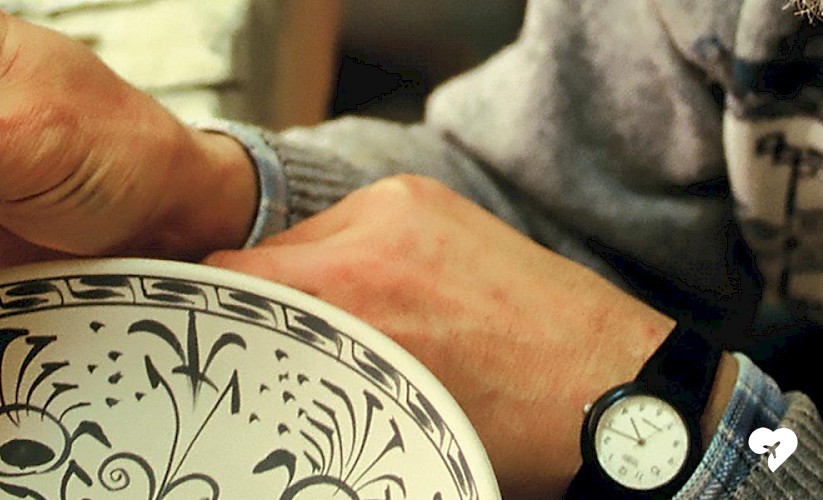Glazed tile and ceramic household stuffs or wallboards of several colours and motifs made by firing the pulped clay soil are called "çini". Çini-making means the craftsmanship shaped around traditional Turkish art of çini since 12th century with its own specific production and adornment techniques like "minai", "luster", "polishing", "underglaze".
Çinicraftspeople generally have used "underglaze technique" since 16th century in their production pursuant to the prescriptions they prepare with their traditional production knowledge about nature. In this technique clay is pulped.
Having shaped, the clay is lined and dried. Next, it is fired in çini ovens and smooth surface called "biscuit" appears. Patterns prepared by drilling on the paper with openwork technique are transformed to the surface with coal dust and the outer contours are drawn by hand with black paint and brush. Later, patterns are dyed with various colours.The surface of çini is covered with glaze and after it is fired at 900-940°C the çini-making is completed.
 Kütahya Tile Bazaar / Photo: Servet Uygun
Kütahya Tile Bazaar / Photo: Servet Uygun
Among çini adornments generally geometric shapes, plants and animal figures symbolizing cosmic thoughts and beliefs are used in different colours. Using red, cobalt blue, turquoise and green on white or navy blue background is the characteristic feature of traditional çinis.
The basic element that characterizes the art of çini is traditional craftsmanship manifested in the applications and the knowledge transmitted from generation to generation about the supply of the raw material, preparation of dyes, production and usage of the tools, firing process, adornment techniques and aesthetics.
Bearers and practitioners of the element are çini craftspeople. It's estimated that more than 5000 çini craftspeople exist in Turkey. In çini workshops there are craftspeople like "çarkçı" shaping çini, "tahrirci" making the decorations, dying the interior parts of the patterns and adornments, "zımparacı" and "rötuşçu" rubbing and undercoating the biscuit, "fırıncı" firing çini, foremen and apprentices who are very effective in transmission and application of the tradition.
Communities and individuals are organized through local NGOs. There are 4 local NGOs in Kütahya and 2 in İznik. Efforts to sustain the tradition have been also maintained through several NGOs working on traditional Turkish handicraft in İstanbul, Ankara and İzmir. Their function in safeguarding, transmitting, introducing and conducting new researches is remarkable.
Ethical manners, knowledge, techniques, prescriptions and rituals of çini-making developed collectively throughout centuries have been conveyed to the present through master-apprentice/parent-child relations. Çini workshops which have been still operating since 14th century especially in Kütahya are well-known cultural spaces to maintain the common memory about the element. Although written permission from the craftspeople is not required in traditional craftsmanship of çini-making, there is a verbal "getting the green light" tradition. The foreman "getting the green light" is accepted by society as a craftsperson who has a command of all production means and process, applies prescriptions and adornment techniques successfully and has gained all the ethical norms of a çini craftsperson; and can train apprentices.

The element has an important cultural function in transmitting to the next generations the knowledge and skills of art of çini, the practices about nature and universe, aesthetic manners, cuisine culture, the space perception.
Since art of çini has been used for mental healing for centuries, it is used as adornment on the public and religious building fronts. Apart from its being an important part of the city identity for Kütahya, İznik and Çanakkale, it is a special part of the city image in terms of giving characteristics to symbolic buildings in metropols like Antalya, Konya, Kayseri, Sivas and İstanbul.
Colours, symbols and allegorical narratives in the patterns of çini that are used as household stuff in daily life and that appear frequently in public and religious buildings. These patterns have reflected the beliefs, world views, life styles, perception of people in an artistic and subliminal way from past to present. Thus, çini-making contribute to strengthening the cultural bond between past and present and transmitting the cultural continuity and sense of identity to the future.
Pursuant to the tradition çini craftspeople and trainers teach çini-making and application techniques to their apprentices and students. They also encourage them to use their time appropriately, to be creative, patient, disciplined, balanced and harmonious. Thus people attending to çini-making courses may develop themselves in terms of having positive mental attitudes, dealing with stress, having healthy social relations, improving creativity and self-confidence.
Besides reaching maturity in technique and style, having a certain ethical understanding is critical to be a craftsperson. Among these ethical understandings, there are not any content against human rights and dignity, equality, personality, different life styles and intercultural respect. In this context, the craftspeople of çini-making never underestimate or marginalize other cultures and their products; on the contrary they always try to establish an inspirational relation by respecting those cultures.
For the inclusion of "Çinicilik", Kütahya, Bursa, Aksaray and Edirne ICH Boards made the involving requests to MoCT in 2008-2010. Then, the Commission of Experts evaluated the nomination proposal for the element and advised to MoCT for inscripion on the ICH National Inventory of Turkey. The element was included in the inventory system in 2013.
Furthermore, taking into consideration the deep knowledge and high level skills required for traditional art of Çini, Sıtkı OLÇAR and Mehmet GÜRSOY proclaimed as Living Human Treasures in 2010.
"Traditional Craftsmanship of Çini-Making" was inscribed on the Representative List of Intangible Cultural Heritage of Humanity in the eleventh session of the Intergovernmental Committee for the Safeguarding of the Intangible Cultural Heritage took place in Ethiopia/ Addis Ababa, from 28 November to 2 December 2016 on behalf of our country.
